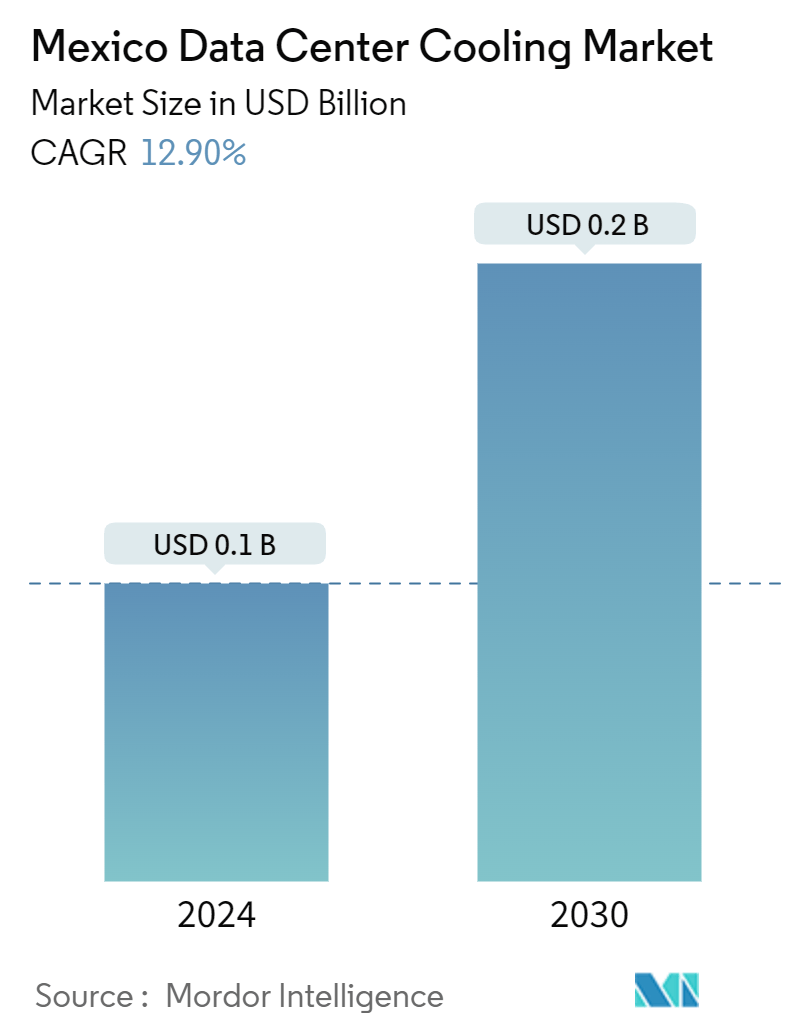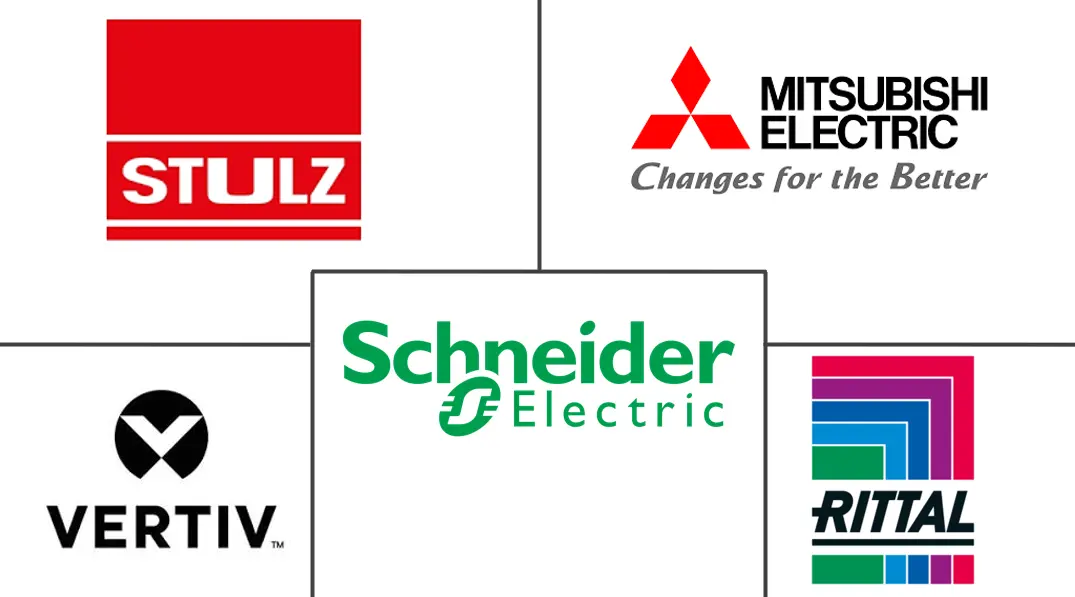Market Size of Mexico Data Center Cooling Industry

| Study Period | 2017 - 2030 |
| Base Year For Estimation | 2023 |
| Market Size (2024) | USD 0.1 Billion |
| Market Size (2030) | USD 0.2 Billion |
| CAGR (2024 - 2030) | 12.90 % |
| Market Concentration | High |
Major Players
*Disclaimer: Major Players sorted in no particular order |
Mexico Data Center Cooling Market Analysis
The Mexico Data Center Cooling Market size is estimated at USD 0.1 billion in 2024, and is expected to reach USD 0.2 billion by 2030, growing at a CAGR of 12.90% during the forecast period (2024-2030).
- The increasing demand for cloud computing among SMEs, government regulations for local data security, and growing investment by domestic players are some of the major factors driving the demand for data centers.
- Under Construction IT Load Capacity: The IT load capacity of the Mexican data center cooling market is expected to reach more than 420 MW by 2030.
- Under Construction Raised Floor Space: The country's construction of raised floor area is expected to increase above 1.8 million sq. ft by 2030.
- Planned Racks: The country's total number of racks to be installed is expected to reach 75 thousand units by 2030. Querétaro is expected to house the maximum number of racks by 2030.
- Planned Submarine Cables: There are many submarine cables under construction in Mexico. One such submarine cable that is estimated to start service in 2025 is Caribbean Express (CX), which stretches over 3,472 km with landing points from Cancún, Mexico.
- The average winter temperature in the country is between -8.33 °C (17 °F) and -0.5 °C (31 °F). The average summer temperature is between 10 °C (50 °F) to over 25 °C (77 °F). Winters can vary widely across the country, with frequent cold, fog, and snow periods in the north and more pleasant weather in the south. Depending upon climatic conditions, DC cooling is done in the DC facilities.
Mexico Data Center Cooling Industry Segmentation
Data center cooling is a system that helps maintain optimal operating temperatures in data center environments. It is critical, as data center facilities house many computer servers and network equipment that generate heat during operation. Efficient cooling systems are used to dissipate this heat and prevent equipment from overheating, ensuring continued reliable operation of the data center. Methods such as air conditioning, liquid cooling, and hot/cold aisle containment are commonly used to control temperature and humidity in data centers.
The Mexican data center cooling market is segmented by technology (air-based cooling [chiller and economizer, CRAH, cooling towers, and other air-based cooling technologies] and liquid-based cooling [immersion cooling, direct-to-chip cooling, and rear-door heat exchanger]), type of data center (hyperscale, enterprise, and colocation), and end-user industry (it and telecom, retail and consumer goods, healthcare, media and entertainment, federal and institutional agencies, and other end-user industries). The report offers market sizes and forecasts in terms of value (USD) for the above segments.
| By Cooling Technology | ||||||
| ||||||
|
| By Type | |
| Hyperscale (Owned and Leased) | |
| Enterprise (On-premise) | |
| Colocation |
| By End-user Industry | |
| IT and Telecom | |
| Retail and Consumer Goods | |
| Healthcare | |
| Media and Entertainment | |
| Federal and Institutional Agencies | |
| Other End-user Industries |
Mexico Data Center Cooling Market Size Summary
The Mexico data center cooling market is poised for significant growth, driven by the increasing demand for cloud computing, stringent government regulations on data security, and substantial investments from local players. The market is characterized by the construction of new data centers that are integrating advanced cooling technologies to address the challenges posed by extreme weather conditions. These facilities are adopting energy-efficient cooling solutions, such as redundant cooling systems and direct liquid cooling, to maintain optimal temperatures and ensure operational continuity during power interruptions. The strategic development of infrastructure, including submarine cables and raised floor space, further supports the expansion of data centers across the country, with Querétaro emerging as a key location for rack installations.
The market landscape is competitive, with major players like Schneider Electric SE, Rittal GMBH & Co.KG, and Mitsubishi Electric Hydronics & IT Cooling Systems SpA leading the charge in providing innovative cooling solutions. The cloud segment is expected to dominate the market, driven by its critical role in supporting SME growth, fostering innovation, and enhancing public services. Additionally, the rise in data consumption from sectors such as manufacturing, media, entertainment, and e-commerce is anticipated to boost the demand for data center cooling infrastructure. The government's initiatives to promote Industry 4.0 and advancements in technologies like quantum computing and 5G are expected to further propel the market, making Mexico a burgeoning hub for data center operations in Latin America.
Mexico Data Center Cooling Market Size - Table of Contents
-
1. MARKET INSIGHTS
-
1.1 Market Overview
-
1.2 Key Cost Considerations for Cooling
-
1.2.1 Analysis of the Key Cost Overheads Related to DC Operations with an Eye on DC Cooling
-
1.2.2 Comparative Study of the Cost and Operational Considerations Related to Each Cooling Technology Based on Key Factors Such as Design Complexity, PUE, Advantages, Drawbacks, Extent of Utilization of Natural Weather Conditions)
-
1.2.3 Key Innovations and Developments in Data Center Cooling
-
1.2.4 Key Energy Efficiency Practices Adopted in Data Centers
-
-
-
2. MARKET SEGMENTATION
-
2.1 By Cooling Technology
-
2.1.1 Air-based Cooling
-
2.1.1.1 Chiller and Economizer
-
2.1.1.2 CRAH
-
2.1.1.3 Cooling Tower (Covers Direct, Indirect, and Two-stage Cooling)
-
2.1.1.4 Other Air-based Cooling Technologies
-
-
2.1.2 Liquid-based Cooling
-
2.1.2.1 Immersion Cooling
-
2.1.2.2 Direct-to-Chip Cooling
-
2.1.2.3 Rear-door Heat Exchanger
-
-
-
2.2 By Type
-
2.2.1 Hyperscale (Owned and Leased)
-
2.2.2 Enterprise (On-premise)
-
2.2.3 Colocation
-
-
2.3 By End-user Industry
-
2.3.1 IT and Telecom
-
2.3.2 Retail and Consumer Goods
-
2.3.3 Healthcare
-
2.3.4 Media and Entertainment
-
2.3.5 Federal and Institutional Agencies
-
2.3.6 Other End-user Industries
-
-
Mexico Data Center Cooling Market Size FAQs
How big is the Mexico Data Center Cooling Market?
The Mexico Data Center Cooling Market size is expected to reach USD 0.1 billion in 2024 and grow at a CAGR of 12.90% to reach USD 0.2 billion by 2030.
What is the current Mexico Data Center Cooling Market size?
In 2024, the Mexico Data Center Cooling Market size is expected to reach USD 0.1 billion.

